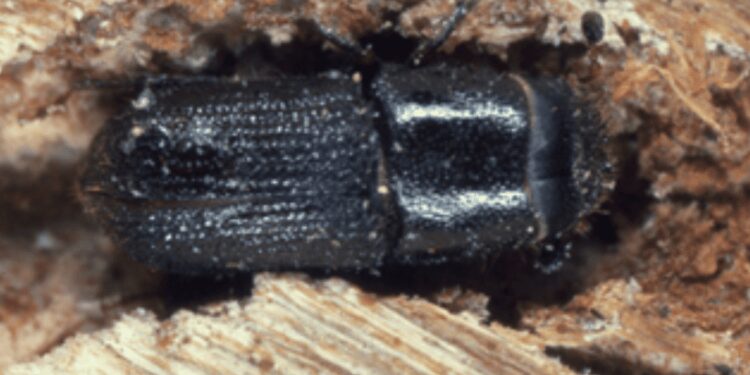A southern pine beetle, which has killed thousands of pine trees on Long Island since it was discovered in 2014, was trapped in the Pine Bush, the northernmost location the invasive, destructive beetles  have ever been found in this country.
have ever been found in this country.
According to the state Department of Environmental Conservation, the single beetle was caught in a trap near Rapp Road. It is considered one of the most destructive forest pests in the U.S. and attacks several species of pine tree including pitch pine, a species that flourishes in the Pine Bush and other pine barrens throughout the state.
Trees infested with the bug, which are only about the size of a grain of rice, only live two to four months.
“The southern pine beetle poses a significant threat to New York’s pine forests,” DEC Commissioner Basil Seggos said. “DEC is actively fighting the infestations of this invasive pest and continues searching for signs of the beetle in upstate New York, to help stay ahead of these destructive pests.

SPB, a bark beetle is native to the southern United States, but has steadily expanded its range north and west.
According to the DEC, the adult beetle enters the tree through crevices in the bark and then creates S-shaped tunnels in the cambium tissue, just beneath the bark. It disrupts the flow of nutrients, killing the tree in typically two to four months. Most trees resist the initial attacks by secreting resin that can “pitch out” some adults and slow the entry of others, but trees almost always die as their defenses are overwhelmed by thousands of attacking beetles.
DEC’s Division of Lands and Forests and the Albany Pine Bush Preserve Commission began placing early detection traps in the preserve in 2015. Additional traps set in the Hudson Valley by DEC and partners confirmed the presence of SPB in Minnewaska State Park, Bear Mountain State Park, Schunnemunk State Park, and Roosa Gap State Forest in 2016 and 2017.
Infested trees, though, have not been found north of Long Island. It is likely the beetles are not flourishing upstate and therefore not causing the widespread tree mortality like on Long Island.

The Pine Bush will be added to the locations of continued aerial and ground monitoring to search for infested trees.
“We’re pleased to be partnering with the forest health experts at DEC to monitor invasive forest pests in the Albany Pine Bush Preserve,” said Christopher Hawver, APBPC executive director. “It’s important in aiding our understanding of the dynamics of the Pine Barrens here in Albany.”
In 2017, Gov. Andrew M. Cuomo targeted $3 million from the Environmental Protection Fund to help manage the spread of SPB. The 2018-19 budget proposes an additional $250,000 for prescribed burns, which will help increase forest health and resistance to SPB on Long Island.
The Pine Bush already does extensive forest thinning and prescribed burning to restore inland pine barrens and maintain the habitat of the endangered Karner blue butterfly.
“Healthy ecosystems better tolerate potentially invasive species,” said APBPC Conservation Director Neil Gifford. “Based on what we know about the management of this insect in its native range to the south, thinning and burning to restore the barrens should also help us make sure SPB does not decimate pitch pine in the preserve.”
DEC is asking the public to report any recently dead or dying pitch pine and red pine they encounter outside of Long Island, especially if there are several trees grouped together and they are dying quickly.
Some signs of infestation include:
- Pitch tubes, or popcorn-shaped clumps of resin on the exterior of the bark
- Shotgun patterned holes on the exterior of the bark
- S-shaped tunnels under the bark
- Pine tree that have recently died are characterized by reddish-brown needles.
Sightings may be reported to the Forest Health Diagnostic Lab by calling the toll-free information line, 1-866-640-0652 or by email, [email protected]. If possible, accompany any email reports with photos of the trees and close-ups of any damage. Please include something in the photos for scale, such as a penny, to help with identification.



